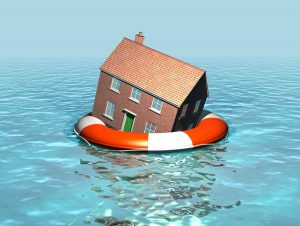New technology and research offers insights

Credit: philhol
2019 is shaping up to be another year for catastrophic flooding and we’re not even into hurricane season yet. The winter’s California floods and this spring’s heavy storms across the Central U.S. have authorities using every piece of new technology at their disposal to predict and control downstream flooding. Meanwhile, inadequate flood controls together with too many uninsured homeowners, is increasing exposure and damages from flood waters during stalled hurricanes, according to researchers.
A study of the last two big hurricanes that stalled to less than 6 mph forward movement – 2018’s Hurricane Florence and 2017’s Hurricane Harvey – looked at the tremendous economic damage caused by the prolonged and torrential rainfall and the flooding that resulted.
Hurricane Harvey was second only to Katrina in total damages, with economic damages of more than $125 billion, of which insurance and reinsurance paid about $19 billion. That same gap existed in Hurricane Florence, with economic damages of about $45 billion, of which $4.6 billion has been covered so far by insurance and reinsurance.
Occurrences of hurricanes that stall aren’t more common, but are causing more harm and more overall damage due to the number of homeowners without flood insurance and inadequate flood controls. The risk the insurance industry faces from stalling hurricanes may be growing even if their frequency is not, especially given the growing exposure in coastal areas.
Meanwhile, on the big Missouri and the even bigger Mississippi Rivers, flood control managers and scientists are waging a weeks-into-months long fight against rising floodwaters from spring storms. They’re armed with the latest technology, which includes drones, special sonar, and supercomputers that are helping predict where rivers are most at risk of breaching their banks.
New estimates show that 13 million people are at risk of major flooding, with more than 200 river gauges in the Mississippi River basin showing various flooding. There’s major flooding from way up north at the Red River in North Dakota downstream south to the mouth of the Mississippi River at the Gulf of Mexico. You can access NOAA’s real-time flood reporting stations here.
One piece of new technology is the National Water Model which came online just a couple of years ago. It assembles data from 5 million river miles of rivers and streams and creates models that simulate how much rainfall and water flow will runoff downstream. Other software performs simulations on the impact of floodwaters on levees and dams, which aided flood forecasts during Hurricane Harvey.
AIR Worldwide, the leading catastrophe modeler in the world, has region-specific damage functions that capture the unique vulnerability of different building types, and users can input additional information such as first floor elevation, foundation type, and flood protection measures for more realistic loss estimates.
Meanwhile the Army Corps of Engineers, the designers of much of our drainage, levees and dams, are using aerial drones to reach previously unreachable areas to send back images and data. They’re also using advanced sonar that can show where debris and other blockages from the riverbeds up to the surface may exist that are impeding water flow.
Scientists say these real-time tools can help emergency managers make better decisions that can save lives and property.
LMA Newsletter of 4-22-19


